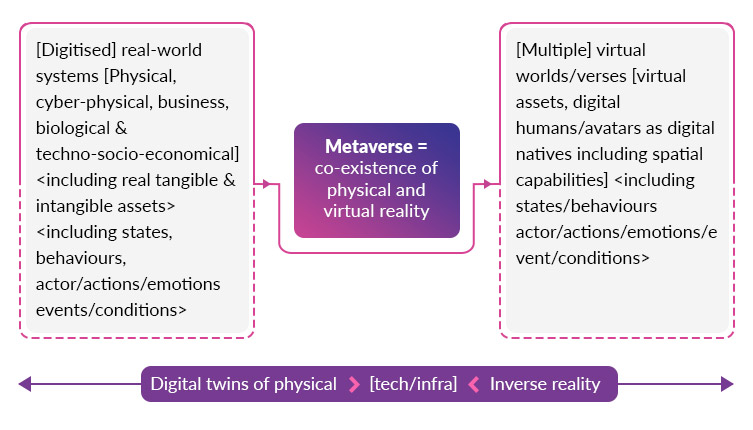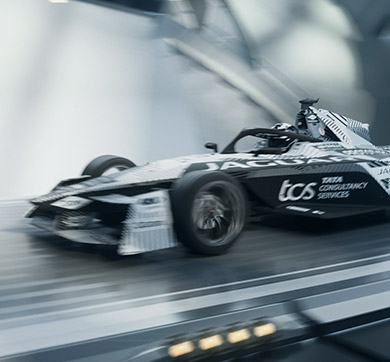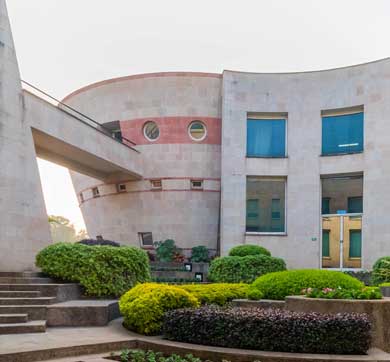July 2022 | 1262 words | 5-minute read
The concept of ‘metaverse’ originated from science-fiction books Neuromancer (1984) and Snow Crash (1992). Neuromancer talked about the concept of cyberspace (a concept describing widespread interconnected digital technologies), and Snow Crash highlighted the first usage of the term Metaverse, a portmanteau of ‘meta’ and ‘universe.'
There is no standard definition of Metaverse. The term is a contested future vision claimed by many companies, research institutions, and independent analyst communities, all driven by different incentives. For the purpose of this article, let us define Metaverse as the next iteration of the internet that will have spatial capabilities (xD-3D/4D/5D and so on) and a virtual economy that works with the real-world economy.

[Illustration adapted from https://arxiv.org/abs/2110.05352]
Multi-Verse, Mini Verses: We expect to see a decentralised and open version of Metaverse as well as a centralised and closed version of Metaverse from various players. The decentralised version is expected to follow the Web 3.0 Playbook (self-sovereignty, value exchange, decentralisation nodes) and the centralised version is expected to follow the Web 2.0 Playbook (rent extraction, hosting/subscriptions and hub-and-spoke-like ecosystem).
There is no standard definition of Metaverse. The term is a contested future vision claimed by many companies, research institutions, and independent analyst communities, all driven by different incentives.
The purpose and experience of Metaverse will differ depending on how each Metaverse is built either for consumer-centric Metaverse applications or Industrial-Metaverse applications or Enterprise-Metaverse applications. The Metaverse following Web 2.0 playbook is expected to piggyback on identity and payment infrastructure built by itself or third party while Metaverse following the Web 3.0 playbook is expected to create its own identity and payment infrastructure based on blockchain, self-sovereign identity and cryptocurrencies or stablecoins. The distinction between Web 3.0 and Web 2.0 Playbooks will define the business model/monetisation opportunities.
Interoperability: Interoperability between multi-verses (multiple Metaverses) will be at different levels/layers. Interoperability includes interoperability for connectivity (networking, communications), persistence (identity, ownership, accounting, history), presentation (graphic models, physical properties), meaning (metadata, semantics, ontologies), behaviour (rules, economics, consequences, power).ref The degree of data portability will vary based on bilateral operating agreements and government regulations and standards for various geographies.
Economy: Consumer-centric Metaverses will focus on monetising through in-Metaverse economy (equivalent to in-game economy) through micro-transactions of digital goods and digital services. Subscription services for ‘specific Metaverse experience’ can be unlocked (like a Disney park experience). Industrial Metaverse may not have a thriving economy, as it will focus on the ‘supply-side’ of the enterprise where industrial companies will view Metaverse as part-of-complex-adaptive systems. Enterprise-focused Metaverse will focus on employee and customer experience including commerce and collaboration inside an enterprise.
Jobs, Roles, Creator/Ownership Economy: Even though it is speculative at present, if we go by the success of Roblox, the online game platform, in the US, or Axie Infinity online game in the Philippines, the Metaverse is expected to provide ‘passive income opportunities’ for real-world citizens. For example, South Korea has invested ref in 40,000 Metaverse-specific job roles and 200+ companies.
Industry observers believe there will be new jobs and economic opportunities around ‘virtual economy’ ref and direct-to-avatar/identities.ref Foresight agencies that track Metaverse talk about scenarios such as “What if a 21-year-old college graduate could use the $250,000 of virtual assets they have accrued as collateral for a mortgage? What if a single parent could use the income that she earns from renting digital real estate to buy groceries? What if a retiree could supplement their pension with the fees, they receive from being a celebrant for virtual weddings?”
Metaverse is expected to facilitate what many in the venture capital community call an ‘ownership economy’ — the idea of owning anything a person creates on the digital web.
Metaverse is expected to facilitate what many in the venture capital community call an ‘ownership economy’ — the idea of owning anything a person creates on the digital web. In this article, we have maintained the landscape of Metaverse lightweight, but the key message is that opportunities around Metaverse will be like how the internet-enabled a technology revolution, where ecosystems around the internet brought sustaining changes to business and society.
When everyone is investing in the Metaverse, what is the right mental model to visualise the opportunities Metaverse will bring for us? At TCS, we believe the Metaverse of today is largely centred around employee and customer experience, and the Metaverse of tomorrow will be part of complex adaptive systems.
Metaverse-as-Destination
Metaverse-as-Destination will be like yet another channel and destination for employees and customers. In the late 1990s, billboard-like websites appeared along with an ecosystem of website builders and domain registrars. Search engines like Google and Yahoo crawled through the web and monetised user attention through ads. The advertising-driven business model became mainstream, and the social network and smartphone accelerated the adoption of the internet.
A similar pattern is emerging now where many brands are considering metaverse as another destination as part of their employee and customer experience strategy. Hence, we believe the current investments (circa 2022) around Metaverse are like what the internet used to be in 1997. The real opportunities of Metaverse, however, will be beyond destinations when Metaverse starts to converge with the real world.
Metaverse-as-Systems
Centred around ‘Industrial Metaverse’ and ‘Next Generation cities’ where Metaverse is seen as part of complex adaptive systems, Metaverse-as-Systems will be part of some complex adaptive systems where simulation intelligence and reality meet.
We see early examples such as Hong Kong International Airport (working with Unity) ref building a Metaverse to simulate real-world events. Unity is not only a game engine that could render a not-yet-real environment but also realistically stress-test the environment for fire, flood, power outage, emergency evacuation scenarios, and so on.
Similarly, Boeing (working with Unity) ref is investing in Industrial Metaverse where the strategy is to build and link virtual 3D digital twin replicas of the jet and propulsion system to run simulations and provide simulation intelligence behaviour.
Future Forward
With Metaverse and Web 3.0 Playbook, the way we work, how we learn, what we trust and buy, who influences us, how we get serviced, and such will be massively reimagined.
With Metaverse and Web 3.0 Playbook, the way we work, how we learn, what we trust and buy, who influences us, how we get serviced, and such will be massively reimagined.
The convergence of physical and digital worlds, our experiences shifting from 2D to 3D/xD and the ability to ‘own’ what we create on the digital web may function as a catalyst for future growth and transformation of business and society. While the incumbent Web 2.0 players and platforms will continue to build their ‘vertical integration’ based ecosystems which is their competitive advantage, the emerging Metaverse and Web 3.0-based players and platforms will aim for building a community and getting the consensus protocols right with all the market participants and market infrastructure players.
When this happens, instead of two or three large digital giants (monopolies and duopolies) commanding bargaining power over the web, we may see niche micro-ecosystems that take principles and values from cooperative societies in the offline world.
TCS and the Metaverse
TCS has already started working on several Metaverse projects including a ‘virtual bank’ for retail transactions and a non-fungible token (NFT) marketplace using its own blockchain solution. Backed by TCS’ Avapresence offering, the platform is built on technology powered by TCS IP and its capabilities in cloud, blockchain, artificial intelligence and the internet of things. It uses core XR (extended reality) elements for the creation and functioning of different Avapresence components.
Dr Ashok Maharaj is head of the TCS Extended Reality (XR) Lab. He holds an MS and a PhD from the Georgia Institute of Technology. Connect with him on LinkedIn.
Parthasarathi V, an innovation evangelist, is associated with the Research & Innovation arm of TCS’ Enterprise Growth group. Connect with him on LinkedIn.













